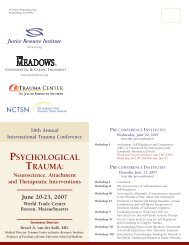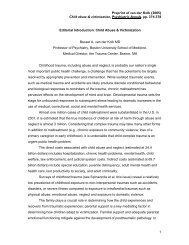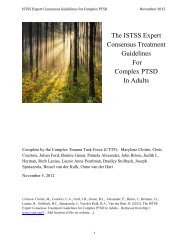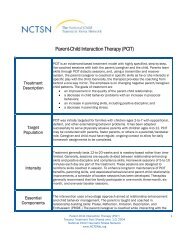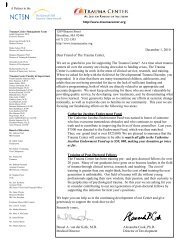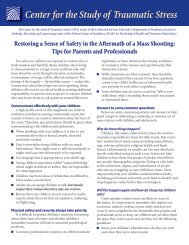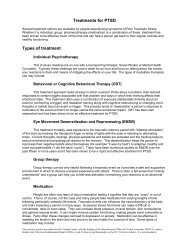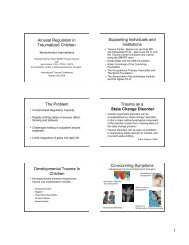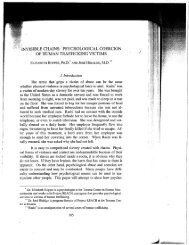in Child Welfare - The Trauma Center
in Child Welfare - The Trauma Center
in Child Welfare - The Trauma Center
Create successful ePaper yourself
Turn your PDF publications into a flip-book with our unique Google optimized e-Paper software.
8 CW360 o <strong>Trauma</strong>-Informed <strong>Child</strong> <strong>Welfare</strong> Practice • W<strong>in</strong>ter 2013<strong>The</strong> Heart of the Matter: Complex <strong>Trauma</strong> <strong>in</strong> <strong>Child</strong> <strong>Welfare</strong>Joseph Sp<strong>in</strong>azzola, Ph.D., Mandy Habib, Psy.D., Angel Knoverek, Ph.D., LCPC, Joshua Arvidson, MSS, LCSW, JanNisenbaum, MSW, Robert Wentworth, MSW, Hilary Hodgdon, Ph.D., Andrew Pond, LICSW, and Cassandra Kisiel, Ph.D.OverviewComplex trauma <strong>in</strong>volves chronic or repeated,typically early-onset exposure to two or moreof the follow<strong>in</strong>g forms of trauma exposure:sexual, physical or emotional abuse, domesticviolence, or neglect, as well as severe caregiverimpairment and school/community violence(Kisiel et al., 2009). A national sample of over2,200 children <strong>in</strong> child welfare found thatover 70% met exposure criteria for complextrauma (Greeson et al, 2011). A substantialsubset of children—typically those withthe fewest social and economic resources,and those liv<strong>in</strong>g amidst poverty, crime orcultural m<strong>in</strong>ority status (Cohen, 2007)—haveexperienced all of these forms of exposure.Complex trauma impacts multiple coredoma<strong>in</strong>s of function<strong>in</strong>g: children’s physiologyand bra<strong>in</strong> development; their ability toidentify, tolerate, control and appropriatelyexpress emotions, impulses and bodilysensations; to concentrate, learn and engage <strong>in</strong>goal-directed behavior; to form a positive andcohesive sense of self, mean<strong>in</strong>gful values andhopeful future outlook; to cultivate secure andhealthy attachment bonds, susta<strong>in</strong> <strong>in</strong>timaterelationships, safely negotiate conflict andcommunicate their needs; and to <strong>in</strong>terpretsocial cues accurately, set healthy personalboundaries and differentiate safe fromthreaten<strong>in</strong>g situations and <strong>in</strong>teractions withpeers and adults (Cook et al, 2005; Kisielet al, 2009; Sp<strong>in</strong>azzola et al, 2005). By thetime they reach adolescence, many complexlytraumatized youth are already caught <strong>in</strong> avortex of <strong>in</strong>tense somatic, behavioral andemotional dysregulation <strong>in</strong> which dailylife is fraught with an ever-expand<strong>in</strong>g hostof traumatic rem<strong>in</strong>ders and subtle falsealarms that activate extremes of hyper- andhypo-arousal. Like “live wires,” complexlytraumatized youth can become chargedwith heightened vigilance and physiologicalreactivity at levels that are emotionallyoverwhelm<strong>in</strong>g and debilitat<strong>in</strong>g to the immunesystem. Like “walk<strong>in</strong>g dead,” they canretreat or slip <strong>in</strong>to extended periods of severewithdrawal, emotional constriction, avoidanceand numb<strong>in</strong>g of consciousness <strong>in</strong>duced viacop<strong>in</strong>g strategies that <strong>in</strong>clude dissociation,b<strong>in</strong>ge eat<strong>in</strong>g or substance dependence.<strong>The</strong> legacy of unresolved complex traumais stagger<strong>in</strong>g, and has been causally l<strong>in</strong>kedwith <strong>in</strong>creas<strong>in</strong>gly dire outcomes across thelifespan that collectively place an enormouseconomic burden on society, conservativelyestimated at over $200,000 per impactedchild and over 100 billion per year (Fang et al,2012). Long-term outcomes <strong>in</strong>clude scholasticfailure, dropout and unemployment; earlypregnancy, sexually transmitted disease,rape and domestic violence; chronic mentaland physical illness, health risk behaviors,<strong>The</strong> legacy of unresolved complex trauma is stagger<strong>in</strong>g, and has beencausally l<strong>in</strong>ked with <strong>in</strong>creas<strong>in</strong>gly dire outcomes across the lifespanthat collectively place an enormous economic burden on society,conservatively estimated at over $200,000 per impacted child and over100 billion per yeardisability and premature mortality (Edwardset al, 2004; Felitti et al, 1998, Ford et al,2010).Psychological maltreatment: <strong>The</strong>sleep<strong>in</strong>g giant of complex traumaPsychological maltreatment has beenrecognized by the American PediatricAssociation as the most prevalent form ofchild maltreatment and thus far the mostoverlooked despite substantial evidence ofits deleterious impact at levels comparableto more readily recognizable forms ofmaltreatment such as physical and sexualabuse (Hibbard et al, 2012). Psychologicalmaltreatment is comprised of various overtand subtle forms of chronic emotional abuseand neglect, <strong>in</strong>clud<strong>in</strong>g prolonged verbalabuse, terroriz<strong>in</strong>g, shunn<strong>in</strong>g, and socialisolation. A recent study on a large sampleof over 5,000 children and adolescents fromthe Core Dataset of the NCTSN revealedpsychological maltreatment to have equal orsignificantly greater association than physicalor sexual maltreatment to 27 out of 30frequency and severity symptom, diagnosticand risk <strong>in</strong>dicators assessed (Sp<strong>in</strong>azzola etal, 2011). Psychologically maltreated youthwere the most likely to exhibit significant<strong>in</strong>ternaliz<strong>in</strong>g, attachment and substanceabuse problems and the most likely todevelop anxiety and depressive disorders. Alsonotable was that exposure to psychologicalmaltreatment resulted <strong>in</strong> equal levels of PTSDsymptom severity compared to physical orsexual abuse. <strong>The</strong> child welfare system canserve as a critical gatekeeper of suspected<strong>The</strong> term complex trauma was<strong>in</strong>troduced by a special taskforceof the National <strong>Child</strong> <strong>Trauma</strong>ticStress Network (NCTSN) to helpmultidiscipl<strong>in</strong>ary service providersbetter understand and respondto the multifaceted relationshipbetween children’s exposure tomultiple traumatic events and thewide-rang<strong>in</strong>g, long-term impactof this exposure (Complex <strong>Trauma</strong>Taskforce, Cook et al, 2003, 2005,2007). <strong>The</strong> complex trauma constructdiffers <strong>in</strong> important ways fromother conceptual frameworksof child maltreatment. Whereas“polyvictimization” addresses thecircumstances of children’s exposureto multiple, often <strong>in</strong>ter-relatedtraumatic forms of trauma (F<strong>in</strong>kelhoret al., 2007, 2009), complex traumaspeaks to the cascad<strong>in</strong>g <strong>in</strong>terplaybetween trauma exposure, impactand (mal)adaptation. Moreover,unlike “Complex PosttraumaticStress Disorder,” <strong>in</strong>troduced <strong>in</strong> anattempt to characterize a broaderand more pronounced symptom-setexhibited <strong>in</strong> a subset of traumatizedadults (Herman, 1992), the complextrauma construct was formulated <strong>in</strong>realization that the PTSD diagnosisneither typically nor sufficientlycaptures the card<strong>in</strong>al featuresof disturbance observed <strong>in</strong> youthexposed to prolonged and severemaltreatment, violence, and neglect(Ackerman et al., 1998; Sp<strong>in</strong>azzola etal., 2005).and reported psychological maltreatment<strong>in</strong> children and families with its power andauthority to open the door to thorough<strong>in</strong>vestigation of its presence and impact <strong>in</strong>reported youth.




